|

WEBINAR:
WEDNESDAY 28 JANUARY 2015, 9:30 - 10:15
The
fall in oil prices has created uncertainty for the Oil & Gas industry
and terminated a five year cycle of windfalls for NOCs, IOCs and oil
producing countries. In this new operating environment, what challenges
lie ahead for players across the industry's value chain?
Join us for a free webinar where senior BMI analysts will forecast the five themes set to dominate the global Oil & Gas industry in 2015. Through our proprietary tools, we'll discuss industry trends for the coming 12 months and highlight which companies and markets will benefit (and suffer) from lower prices.
Topics
for discussion include:
*
Global Supply and Demand oil balance
*
Capex
*
M&A
*
Technology and innovation
*
LNG producers
REGISTRATION
The
webinar is free of charge and places are offered on a first come
first served basis. Registered delegates who are unable to participate on
the day will be sent a recording after the event. Click on the links above
to register.
ASK
THE ANALYSTS
Do
you have a question that you would like our analysts to address? Send
in your questions now and they'll do their best to cover
as many as possible during the webinar.

NOVEMBER
21 2014 -
MARINE LINK - BUNKER FUEL PRICE DROP
For a ship that burns 24 tonnes of fuel per day while steaming, fuel costs are reduced by as much as $1 million a year if current price levels stay put. Assuming a difference from the average of first half of 2014 at $578 for 380 cSt, High Sulphur Fuel Oil (HSFO) in Rotterdam, to a new level of $412, and a sailing time of 70%.
On an industry-wide scale, the drop has reduced the entire international shipping industry’s daily bunker cost by
$117 million per day. Assuming an annual market for bunker fuels 257 million tons, bought at spot price and a drop in prices by $166 per mt on HSFO. Actually, it may be even slightly higher as prices for Marine Gas Oil (MGO) has slid $215 per mt, but no adjustment made for that.
Chief Shipping Analyst at
BIMCO, Peter Sand is quoted as
saying: “The drop in oil prices mirrors the disappointing development in the global GDP growth
figures." "Despite the lower prices, bunkers remain the single most significant cost item for owners and operators. For a Handymax in current markets using abt. 24 tonnes a day, bunker cost amount to $10,000, close to twice the amount spent on OPEX (abt. $5,500 per day)."
“Slow steaming is expected to remain an integrated part of shipping going forward in spite of the falling prices, as bunker cost are still significant and so is overcapacity in the freight market."
“The fall in oil prices and a strong start to the winter season have spurred demand for tankers lifting earnings within all tanker segments considerably."
The unrest in the
financial markets starting in Q3 and continuing into Q4 have sent the global oil prices down. Due to more than adequate supply and less than adequate demand. Demand side being the real trouble as the ongoing world economic recovery
keeps “postponing” the arrival of a sustainable global and regional economic growth level.
According to IEA: “Specific economic concerns regarding Europe,
China and
Russia act as a drag on the forecast, removing 0.4 mb/d from the 4Q14 estimate compared to last month's Report [September], but year-on-year (y-o-y) growth still accelerates to 765 kb/d for 4Q14.
The upside from the slide in oil prices is lower costs of energy for all including the shipping industry, which welcomes lower bunker prices.

JULY
9 2014 - PENTAGON USES WRONG FUEL PRICE & FAILS TO HEDGE FUEL BILL
The U.S. Department of Defense has been using the wrong oil price in its budget, leaving the largest single buyer of fuel in the world with liabilities potentially hitting billions of dollars.
The Pentagon continues to rely on WTI prices even though Brent oil is more relevant to the cost of fuels it buys on behalf of the armed forces.
Using the wrong benchmark has introduced increasing risk into the military budget, according to a critical report published on Tuesday by the Government Accountability Office (GAO) ("Bulk Fuel Pricing: DOD needs to re-evaluate its approach to better manage the effect of market fluctuations").
Moreover, the Department of Defense (DOD) still does not hedge its exposure to changing fuel prices, even though the Pentagon's Defense Logistics Agency (DLA) buys more than 100 million barrels of fuel each year at a cost of $10 billion to $20 billion, according to the GAO.
The DLA purchases fuel on the open market and then sells it to the armed forces at a standard price.
Differences between the standard price and actual cost of buying fuel are absorbed into the Defense-wide Working Capital Fund.
SETTING
A STANDARD FUEL PRICE
The standard price is based on a forecast for crude oil prices plus a mark-up to cover the cost of refining and another mark-up for non-product costs (including storage, transport and any cost-recovery adjustments to offset prior-year gains and losses in the Working Capital Fund).
Like the rest of the federal government, the Department of Defense is required to use crude oil price forecasts provided by the Office of Management and Budget (OMB) and jointly prepared by the OMB, the U.S.
Treasury and the White House Council of Economic Advisors.
The DLA adds its own estimate for refining costs. The DLA and the comptroller of the Defense Department then add a further element to account for non-product costs (including any previous losses in the Working Capital Fund).
For example, for the 12 months ending on Sept. 30, 2013, the DLA set a standard price of $156.66 per barrel - which consisted of a base crude price of $93.28 plus a refining mark-up of $46.64 and non-product costs of $16.74.
Because of the Defense Department's lengthy budget planning cycle, standard fuel prices have to be set 18 months before the fuel is actually purchased.
The long delay exposes the system to an enormous amount of price risk.
On average, actual fuel costs have differed from estimated costs by more than 20 percent in the last five years.
Some of the difference can be accounted for by operational requirements varying from estimates, but about three quarters has been due to changes in market prices, according to the GAO, the congressional watchdog on spending, waste and fraud.
SHIFTING
CASH BETWEEN ACCOUNTS
The DLA's Working Capital Fund is intended to absorb short-term fluctuations in the market price of fuel and give each of the armed services some certainty in developing their own operating budgets.
But the fund is meant to be revenue-neutral. Losses and gains are supposed to cancel out over time, ensuring the fund breaks even.
In theory, the standard price is set once per year. Losses in the Working Capital Fund, however, can be covered by within-year adjustments to the standard price.
In the five fiscal years from 2009 to 2013, standard prices were adjusted 13 times. The standard price was increased six times and decreased seven times. Fiscal 2013 was the first time since 2004 that the standard price remained unchanged all year.
However, changes in the standard price "are not the preferred option for managing the fund's cash balances because of the potential strain it places on the services' budgets", according to Pentagon officials interviewed by the GAO.
Price rises force the services to reduce fuel consumption by cutting training or ask Congress for emergency funding.
Instead, the Defense Department usually transfers unspent funds from other parts of its budget. In fiscal 2012, the Pentagon transferred $1.3 billion from the Afghanistan Security Forces Fund to plug a shortfall in the Working Capital Fund. In fiscal 2013, it transferred another $1.4 billion from various accounts, including the Foreign Currency Fluctuations account, according to the GAO.
Transfers can work the other way, too. In fiscal 2011, Congress noted excess cash balances in the Working Capital Fund, and reduced funding for various operations and maintenance accounts by $2 billion. The Pentagon responded by transferring $1.3 billion out of the fund to make up for the shortfalls in operations and maintenance accounts.
The GAO found evidence that transfers into and out of the Working Capital Fund affect the standard price. In fiscal 2011, the standard price charged to the armed services was raised $40 per barrel because there was no longer enough cash in the fund to cover fuel costs after money had been transferred to other accounts.

PENTAGON
DOES NOT HEDGE
Despite the long delay between setting the fuel budget and purchasing fuel, the Department of Defense does not hedge.
In 2004, the Defense Business Board recommended the Pentagon explore a limited low-risk hedging strategy ("Report to the Senior Executive Council, Department of Defense: Fuel Hedging Task Group", March 2004).
The Business Board received advice from BP,
Shell, Morgan
Stanley, Accenture,
Delta Airlines and McKinsey, so it is not surprising it reached a favourable conclusion about hedging.
The Pentagon "could feasibly hedge its fuel purchases", the board concluded, by designing "an effective hedging program that does not disrupt commercial markets".
The Business Board recommended the Pentagon seek congressional approval to implement a non-market hedging programme with the Department of the Interior.
Interior's Minerals Management Service, now part of the Office of Natural Resources Revenue, receives royalties from oil and gas produced on federal lands.
When oil prices climb, the Pentagon pays more for fuel, but Interior receives higher royalty payments.
The Business Board wanted the Pentagon to seek congressional authorisation to enter a swap arrangement whereby whichever department benefited from price changes would transfer funds to the other.
"Such an approach would allow DOD to realize some of the benefits of fuel hedging while avoiding many of the potential adverse effects associated with hedging in commercial markets," the board concluded.
Nonetheless, the Defense Department has elected not to pursue a hedging strategy, even with the Department of the Interior. Pentagon officials say hedging is outside the scope of their current authority, would incur management fees, would increase total costs, and poses additional political and economic risks.
The Pentagon does not even enter into firm fixed-price contracts to buy fuel from major suppliers. Fixed-price contracts would shift price risk to suppliers and the department has concluded it would end up paying a premium for them, increasing certainty about fuel prices but at the cost of paying more for fuel over the long term.
EMPLOYING
THE WRONG BENCHMARK
The GAO expressed no view on whether the Pentagon should start hedging, but it did recommend officials at least start using a more accurate benchmark to forecast their costs.
The DLA buys 48 percent of its fuel abroad where prices tend to be tied to Brent. But even for fuel purchased in the United States, product prices tend to track Brent rather than WTI.
However, the DLA has stuck to using WTI. As Brent and WTI prices have diverged, the DLA has tried to compensate for the discrepancy by adjusting the mark-up it includes for refining.
In fiscal 2013, the DLA included a refining mark-up of almost $47 per barrel, representing a theoretical refining margin of 50 percent.
No refinery anywhere in the world makes a margin that large. Not only is the mark-up inaccurate from an accounting perspective, it risks introducing even more risk and uncertainty into the budget process.
"DOD is using the mark-up not only to account for refinement costs, but to cover the price spread between WTI and other crude oil pricing benchmarks," the GAO grumbled.
"By using the increased refinement mark-up to compensate for the price spread, DOD is not addressing the underlying limitations with its crude oil baseline."
The GAO observes that the all-powerful Office of Management and Budget has this year begun supplying forecasts for Brent as well as WTI, though the Pentagon like other federal agencies has discretion over which benchmark it uses in its budget.
In fact, the Pentagon's total fuel costs most closely track the price of commercial jet fuel, rather than either crude benchmark, according to the GAO.
The Air Force accounts for about half the total fuel consumption, with the rest split between the
Navy and the Army.
But the Department of Defense has not considered whether using a crude oil baseline is still reasonable at all, let alone which one, the auditors complained.
The DOD has promised to re-evaluate its approach for estimating the components of the standard price, but has not said whether it will change its benchmark.
WEN article by John Kemp, Editing by Dale Hudson
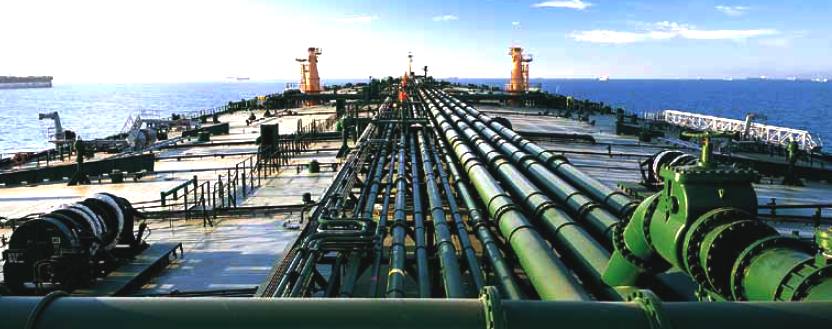

MAY
7 2014 - MARINE LINK - Climate Rules Could Put $1.1 Trl In Oil Investment At Risk
Investors could spend up to $1.1 trillion over the next decade on oil projects and assets that never reach production if governments enforce measures to curb climate change, a report by Carbon Tracker Initiative said.
The Carbon Tracker report, released on Thursday, could help funds and other investors avoid putting their money in oil assets that remain buried forever.
The $1.1 trillion, around 15 percent of the decade's total global oil and gas spending at current rates, is earmarked for projects to 2025 that require a market price of at least $95 a barrel to break even.
That investment is at risk if governments enforce plans to curb the global rise in temperatures to 2 degrees Celsius, which scientists say is the threshold for avoiding the worst effects of climate change.
Almost 200 nations have endorsed that goal and are due in 2015 to sign up to cut greenhouse gas emissions to help meet it.
Those measures will cut demand for fossil fuels including oil and lower prices and revenues, according to the report.
"Gambling on a $95/bbl oil price on behalf of shareholders is risky, given that oil prices have dropped to $40 per barrel twice in the last decade," James Leaton, Carbon Tracker's research director, said in a statement released on Thursday.
The International Energy Agency (IEA) said last year that even under current policies half of proven fossil fuel reserves would be left undeveloped to 2050 and that this percentage would increase as governments impose tougher curbs.
The oil industry is coming under increasing pressure from investors to reduce exposure to high-cost, risky projects and also to report the risks to their business from climate policies.
"The Carbon Tracker report will be useful to investors engaging oil companies on whether they are using shareholder capital prudently as we transition to a lower-carbon future," Anne Stausboll, chief executive of Calpers, the largest U.S. public pension fund in the United States, said in a statement.
HIGH EXPOSURE
Benchmark Brent crude is trading at around $107 a barrel and has mostly held above $100 for the past three years.
Spurred by the historically high prices, companies have increased exploration in areas such as the Arctic and ever-deeper coastal waters.
The private sector is the major funder of these high cost projects, exceeding state-owned producers such as Russia's Rosneft and Saudi Aramco.
Smaller independent producers have the highest percentage exposure, but big firms including Exxon Mobil Corp, Royal Dutch Shell and Total have significant parts of their portfolios at risk, Carbon Tracker said.
Many companies say they are addressing climate policies by focusing on energy efficiency and low-carbon technologies such as renewable power generation and carbon capture and storage.
Exxon, the world's largest publicly traded oil company, has said there is little risk to its reserves because they will be needed to meet expected growth in energy demand.
The Carbon Tracker Initiative is funded by several U.S. and European foundations, including the Rockefeller Brothers Fund and the Joseph Rowntree Charitable Trust.

MAY
5 2014 - EPA $9 MILLION FOR CLEAN DIESEL
The United States Environmental Protection Agency
(EPA) has made available $9 million in grant funding for nationwide clean diesel initiatives that aim to reduce diesel pollution and emissions exposure from the nation's existing fleet of
diesel
engines.
The initiative was launched by the EPA’s Diesel Emission Reduction Program (DERA), which started in 2008 with the goal of improving air quality and health by reducing pollution throughout the United States. Though in most cases diesel engines are extraordinarily efficient and reliable, research has shown that their emission of air pollutants such as nitrogen oxides (NOx) and particulate matter (PM), not only harm the environment, but also pose a number of adverse health effects. The EPA estimates that clean diesel funding generates up to $13 of public health benefit for every $1 spent on diesel projects.
Offering grant money for diesel emission reduction projects (exhaust control/reduction device installations, equipment upgrades and vehicle/engine replacement, to name a few options), the new clean diesel project will target the most cost-effective projects and fleets operating in areas designated as poor air quality areas. The EPA said it expects to award 10-20 assistance agreements across the U.S. transportation industry, including, of course, the marine sector. Other possible projects include school/transit
buses, heavy-duty diesel trucks, locomotives, etc.
Proposals to be submitted to the EPA before June 17, 2014. The EPA said it has already awarded more than 600 DERA grants across the U.S., leading to the reduction of more than 250,000 tons of NOx and more than 14,000 tons of PM.
MARITIME
PROFESSIONAL - Saturday
12 April 2014
U.S. crude oil rose to near a six-week high on Friday 11-4-14 steered by stronger gasoline demand and a positive consumer confidence report, but gains were capped by profit taking and a declining demand outlook.
The International Energy Agency lowered its global demand forecast for 2014 due to expectations that more Libyan crude will reach the market next week, pushing Brent prices lower.
U.S. crude moved in tandem with U.S. gasoline prices, which surged early in the session due to government data released mid-week that showed a substantial draw on stockpiles, signaling robust demand before the start of summer driving season.
Data showing U.S. consumer sentiment rose to a nine-month high in April also provided support, and pushed the American benchmark's price discount to Brent to its narrowest since mid-September.
Brent's price slipped after Russia backed off threats it made Thursday to disrupt Ukraine's natural gas supply, and therefore Europe's, unless Kiev paid its bill. Russian President Vladimir Putin guaranteed Friday "fulfillment of all our obligations to our European consumers."
"The reason we had a late day sell off is book squaring," said Phil Thompson, director of Mobius Risk Group in Houston. "Once U.S. crude got up to $104.50 there was profit taking, and RBOB had correlated moves with (U.S. crude) all day" triggering a sell off in gasoline, as well, Thompson
is quoted as saying.
U.S. oil rose by as much as $1.04 to a session high of $104.44, before giving back much of its gains to settle 34 cents higher at $103.74 a barrel. The May contract rose nearly 2-1/2 percent on average over last week.
U.S. gasoline RBOB rose by as much as 3.35 cents to a session high of $3.0381 per gallon, but gave up most gains to settle 0.65 cents higher at $3.0144 per gallon.
Brent crude settled 14 cents lower at $107.33 a barrel, but still ended the week 0.5 percent higher on average.
The Brent-U.S. crude oil spread contracted as tight as $3.26, and settled at $3.59, its narrowest settlement since Sept. 19.
Both contracts were pressured after the IEA said in a monthly market report that global demand growth would average 1.29 million barrels per day (bpd) in 2014, down 60,000 bpd from its previous forecast.
This followed a similar trimming of the demand forecast by the Organization of the Petroleum Exporting Countries in its monthly report on Thursday to 29.65 million bpd in 2014, down 50,000 bpd from the previous estimate.
Tensions between the West and Russia over
Ukraine remained a potential market mover after U.S. President
Barack Obama and
German Chancellor Angela Merkel discussed further sanctions against Russia, calling on Moscow to move its troops back from the border region.
The possibility that Libyan oil exports will pick up next week if some of its oil ports reopen remains as a bearish factor in Brent prices.
Libya's state National Oil Corp lifted a force majeure for the eastern port of Hariga on Thursday, but the country's two biggest ports, Es Sider and Ras Lanuf, remain blocked.
Late on Friday, the U.S. Commodity Futures Trading Commission released data showing the speculator group increased their net long U.S. crude futures and options positions in the week to Tuesday, April
8 2014.
LLOYDS
REGISTER & UNIVERSITY COLLEGE LONDON ENERGY INSTITUTE - MARCH 2014
Heavy fuel oil will remain the main fuel for deep sea shipping in year 2030 indicates new research from Lloyd’s Register and University College London’s Energy Institute. In a complex study involving many inter-related factors, ‘Global Marine Fuel Trends 2030’ (GMFT 2030) limits itself to the container ship, bulk carrier/general cargo and tanker (crude & chemical/products) sectors which represent about 70% of the shipping industry’s fuel demand.
Marine fuels considered - Ranged from liquid fuels used today (HFO, MDO/MGO) to their bio-alternatives (bio-diesel, straight vegetable oil) and from LNG and biogas to methanol and hydrogen (derived both from methane or wood biomass) were included in the study.
Engine technologies - Included were 2 or 4-stroke diesels, diesel-electric, gas engines and fuel cell technology. Since the uptake of certain fuels is influenced by them, a wide range of energy efficiency technologies and abatement solutions (including sulphur scrubbers and Selective Catalytic Reduction for NOx emissions abatement) compatible with the examined ship types were included in the modelling.
Three scenarios applied - Shipping is the enabler of world trade – if world trade grows then so will seaborne tonne miles of cargo. The Global Merchant Trends 2030 report issued last year indicates we can expect strong growth for shipping. With emissions regulations and rising energy costs, shipping decision makers will benefit from a clearer understanding of the potential scenarios for marine fuel demand. These were:
Status Quo – The world will continue its current growth momentum with some booms and busts over the next twenty years.
Global Commons – A shift to concern over resource limitation and environmental degradation will see a desire for a more sustainable world being developed and fairness in wealth distribution. Governments will find common ground and accelerated economic growth, within a framework of sustainable development, which will follow.
Competing Nations – States act in their own national interest. There will be little effort to forge agreement amongst governments for sustainable development and international norms. This is a self-interest and zero-sum world with a likely rise in protectionism and slower economic growth.
BRIEF CONCLUSION: FUEL MIX 2030
Heavy fuel oil (HFO) will still be very much around in 2030, but in different proportions for each scenario: 47% in Status Quo, to a higher 66% in Competing Nations and a 58% share in Global Commons, the most optimistic of scenarios for society. A high share of HFO, of course, means a high uptake of emissions abatement technology when global emissions regulations enter into force.
The declining share of HFO will be offset by low sulphur alternatives (MDO/MGO or LSHFO) and by LNG, and this will happen differently for each ship type and scenario. LNG will reach a maximum 11% share by 2030 in Status Quo.
Interestingly, there is also the entry of Hydrogen as an emerging shipping fuel in the 2030 Global Commons scenario which favours the uptake of low carbon technologies stimulated by a significant carbon price.
To download a PDF of the report go to
www.lr.org/gmft2030, hard copies can be ordered from the Lloyd’s Register Webstore at
www.webstore.lr.org
BUNKER
FUEL DESCRIPTION
Bunker fuel is technically any type of fuel oil used aboard ships. It gets its name from the containers on ships and in ports that it is stored in; in the early days of steam they were coal bunkers but now they are bunker fuel tanks. The
Australian Customs and the Australian Tax Office define a bunker fuel as the fuel that powers the engine of a ship or aircraft. Bunker A is No. 2 fuel oil, bunker B is No. 4 or No. 5 and bunker C is No. 6. Since No. 6 is the most common, "bunker fuel" is often used as a synonym for No. 6. No. 5 fuel oil is also called navy special fuel oil or just navy special; No. 5 or 6 are also commonly called heavy fuel oil (HFO) or furnace fuel oil (FFO); the high viscosity requires heating, usually by a recirculated low pressure steam system, before the oil can be pumped from a bunker tank. Bunkers are rarely labeled this way in modern maritime practice.
Since the 1980s the International Organization for Standardization (ISO) has been the accepted standard for marine fuels (bunkers). The standard is listed under number 8217, with recent updates in 2005 and 2010. They have broken it down to Residual and Distillate fuels. The most common residual fuels in the shipping industry are RMG and RMK. The differences between the two are mainly the density and viscosity, with RMG generally being delivered at 380 centistokes or less, and RMK at 700 centistokes or less.
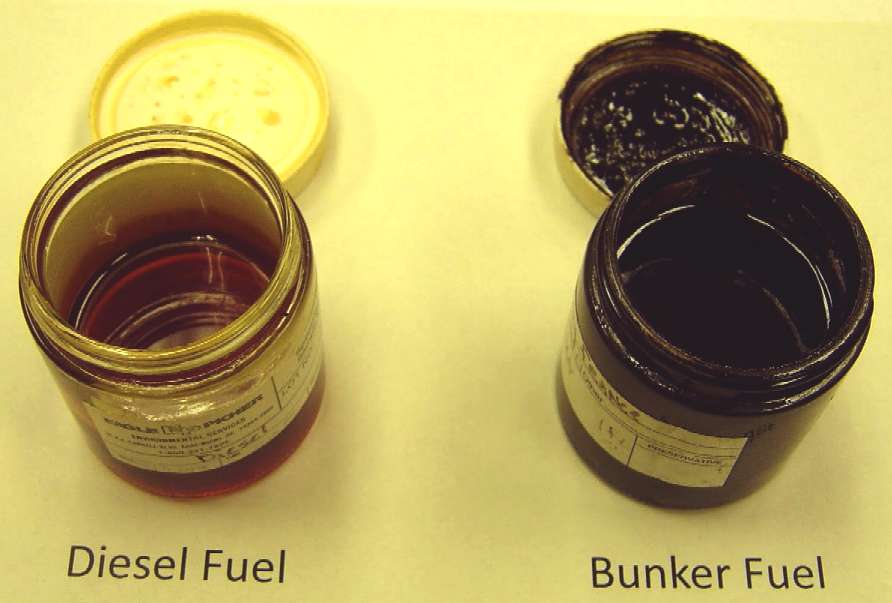
Ships with more advanced engines can process heavier, more viscous, and thus cheaper, fuel. Governing bodies (i.e. California, European Union) around the world have established Emission Control Areas (ECA) which limit the maximum sulfur of fuels burned in their ports to limit pollution, reducing the percentage of sulfur and other particulates from 4.5% m/m to as little as .10% as of 2015 inside an ECA. As of 2013 3.5% continued to be permitted outside an ECA. This is where Marine Distillate Fuels and other alternatives to use of heavy bunker fuel come into play. They have similar properties to Diesel #2 which is used as road Diesel around the world. The most common grades used in shipping are DMA and DMB. Greenhouse gas emissions resulting from the use of international bunker fuels are currently included in national inventories.
Small molecules like those in propane, naphtha,
gasoline for
cars, and jet fuel have relatively low boiling points, and they are removed at the start of the fractional distillation process. Heavier petroleum products like diesel and lubricating oil are much less volatile and distill out more slowly, while bunker oil is literally the bottom of the barrel; the only things more dense than bunker fuel are carbon black feedstock and bituminous residue which is used for paving roads (asphalt) and sealing roofs.
|
Mobil
|
Chevron
|
Esso
|
Shell
|
Texaco
|
|
.
|
.
|
.
|
.
|
.
|
|
Motorship
Fuel Oil
|
Intermediate
Bunker Fuel (BF*)
|
Bunker
Fuel Oil (BFO)
|
Marine
Fuel Oil (MFO*)
|
Interfuel
(IF*)
|
|
Light
Marine Fuel Oil (LMFO)
|
Intermediate
Bunker Fuel (BF*)
|
Intermediate
Fuel (IF*)
|
Marine
Fuel Oil (MFO*)
|
IF*
|
|
Marine
Diesel Oil (MDO)
|
Marine
Diesel Oil (MDO)
|
Marine
Diesel Oil (MDO)
|
Marine
Diesel Oil (MDF)
|
Marine
Diesel Oil (MDO)
|
|
Distillate
Marine Diesel Oil
|
Light
Diesel
|
Light
Diesel Oil (LDO)
|
Marine
Diesel Fuel or Gas Oil (MDF/GO)
|
Marine
Distillate
|
|
Marine
Gas Oil (MGO)
|
Gas
Oil (GO)
|
Marine
Gas Oil (MGO)
|
Gas
Oil (GO)
|
Gas
Oil (GO)
|
|
Notes:
* Denotes a specific grade, usually shown by viscosity of the
grade in cSt at 50°C
|
TERMINOLOGY
To communicate effectively in a speciality field like "marine-fuels" it is necessary to be clear on the bunker fuel terminology used in this industry. Distillate fuels are commonly called "Gas Oil" or Marine Gas Oil; residual fuels are called Marine Fuel Oil or Residual Fuel Oil; and intermediate types are called "Marine Diesel Fuel", or Intermediate Fuel Oil (IFO). While the term "diesel fuel" for land based automobile and truck use is 100% distillate, in the marine industry Marine Diesel Fuel is the blend of distillate and residual oils (intermediate types). The 100% distillate type fuel in the marine industry is the Marine Gas Oil (implying that it was boiled into a gas, then condensed into a liquid).
Fuel Oil, or Residual Fuel Oil, refers to fuels that are primarily non-boiling fractions. Depending on the pressures and temperatures in refinery distillation processes, and the types of crude oils, slightly more or less gas oil that could be boiled off is left in the non-boiling fraction, creating different grades of Residual Fuel Oils. In other words, intermediate grades of fuel oil can be made directly in the distillation process or by blending with distillate. Another clarification that is necessary in this study involves the terms "recreational" versus "commercial" uses of marine vessels. The Environmental Protection Agency, EPA, has defined the terms "recreational marine engine" and "recreational vessel" in 40 CFR Part 94: Control of Emissions of Air Pollution from New CI Marine Engines >37 kW.
One common theme is that the world of commercial marine fuel supply is totally separate from the world of recreational marine fuels. Diesel fuel for marine applications depends on three things: engine used, cost, and availability. Commercial marine businesses have the higher volume and low-cost incentives to arrange deals with refiners to produce tailored marine fuels that are most cost effective for their engines. Commercial marine businesses arrange for fuels that involve less refining (leaving the sulphur in the fuel), and therefore lower cost than other diesel fuels, delivered by pipeline, boat or barge.
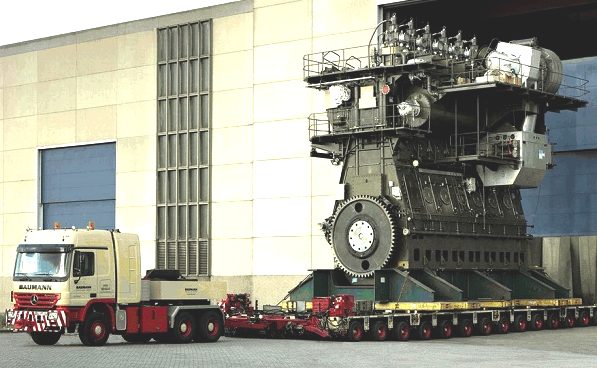
State
of the art Wartsila diesel engines for oil tankers and cruise liners may
soon become an outdated technology as solar and wind powered vessels
become economically viable due to clean air laws. Our patent energy
harvesting system may soon herald in zero carbon cargo vessels and cruise
liners.
CLASSIFICATION
In the maritime field another type of classification is used for fuel oils:
* MGO (Marine gas oil) - roughly equivalent to No. 2 fuel oil, made from distillate only.
* MDO (Marine diesel oil) - A blend of heavy gasoil that may contain very small amounts of black refinery feed stocks, but has a low viscosity up to 12 cSt so it need not be heated for use in internal combustion engines.
* IFO (Intermediate fuel oil) A blend of gasoil and heavy fuel oil, with less gasoil than marine diesel oil.
* MFO (Marine fuel oil) - same as HFO (just another "naming").
* HFO (Heavy fuel oil) - Pure or nearly pure residual oil, roughly equivalent to No. 6 fuel oil
Marine diesel oil contains some heavy fuel oil, unlike regular diesels. Also, marine fuel oils sometimes contain waste products such as used motor oil.
Carcinogen levels are high.
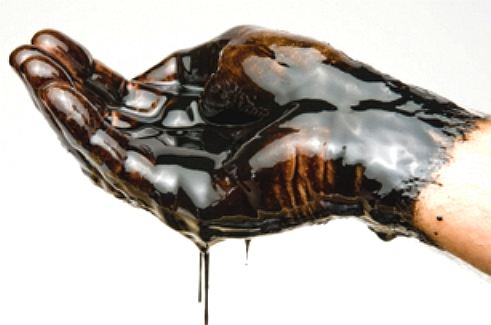
STANDARDS
CCAI and CII are two indexes which describe the ignition quality of residual fuel oil, and CCAI is especially often calculated for marine fuels. Despite this marine fuels are still quoted on the international bunker markets with their maximum viscosity (which is set by the ISO 8217 standard - see below) due to the fact that marine engines are designed to use different viscosities of fuel. The unit of viscosity used is the Centistoke and the fuels most frequently quoted are listed below in order of cost, the least expensive first -
* IFO 380 - Intermediate fuel oil with a maximum viscosity of 380 Centistokes (<3.5% sulphur).
* IFO 180 - Intermediate fuel oil with a maximum viscosity of 180 Centistokes (<3.5% sulphur).
* LS 380 - Low-sulphur (<1.0%) intermediate fuel oil with a maximum viscosity of 380 Centistokes.
* LS 180 - Low-sulphur (<1.0%) intermediate fuel oil with a maximum viscosity of 180 Centistokes.
* MDO - Marine diesel oil.
* MGO - Marine gasoil.
*LSMGO - Low-sulphur (<0.1%) Marine Gas Oil - The fuel is to be used in EU community Ports and Anchorages.
* ULSMGO - Ultra Low Sulphur Marine Gas Oil - referred to as Ultra Low Sulfur Diesel (sulphur 0.0015% max) in the US and Auto Gas Oil (sulphur 0.001% max) in the EU. Maximum sulphur allowable in US territories and territorial waters (inland, marine and automotive) and in the EU for inland use.
The density is also an important parameter for fuel oils since marine fuels are purified before use to remove water and dirt from the oil. Since the purifiers use centrifugal force, the oil must have a density which is sufficiently different from water. Older purifiers had a maximum of 991 kg/m3; with modern purifiers it is also possible to purify oil with a density of 1010 kg/m3.
The first British standard for fuel oil came in 1982. The latest standard is ISO 8217 from 2005. The ISO standard describe four qualities of distillate fuels and 10 qualities of residual fuels. Over the years the standards have become stricter on
environmentally important parameters such as sulfur content. The latest standard also banned the adding of used lubricating oil
(ULO).
TRANSPORTATION
Fuel oil is transported worldwide by fleets of oil tankers making deliveries to suitably sized strategic ports such as Houston, Singapore, Fujairah, Balboa, Cristobal, Algeciras and Rotterdam. Where a convenient seaport does not exist, inland transport may be achieved with the use of barges. The lighter fuel oils can also be transported through pipelines. The major physical supply chains of Europe are along the Rhine.
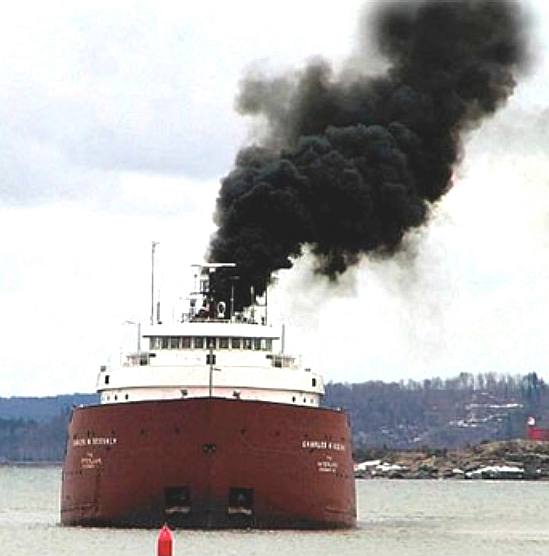
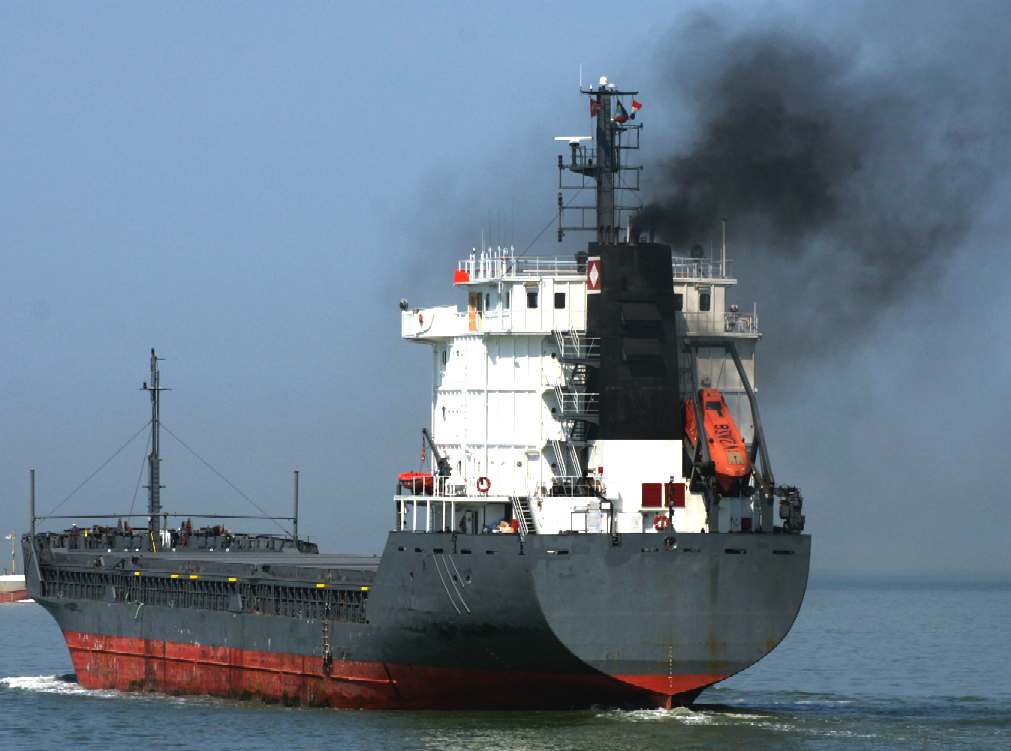
Letting
off steam. A couple of Smoky-Joes. Multiply these pictures by 100,000 and
you begin to see the scale of the problem.
MERCHANT
SHIPPING (POLLUTION) ACT 2006
The Merchant Shipping (Pollution) Act 2006 (c 8) is an Act of the Parliament of the United Kingdom. It has three main purposes: to give effect to the Supplementary Fund Protocol 2003, to give effect to Annex IV of the
MARPOL Convention, and to amend section 178(1) of the Merchant Shipping Act 1995.
MARPOL
73/78
Marpol 73/78 is the International Convention for the Prevention of Pollution From Ships, 1973 as modified by the Protocol of 1978. ("Marpol" is short for marine pollution and 73/78 short for the years 1973 and 1978.)
Marpol 73/78 is one of the most important international marine environmental conventions. It was designed to minimize pollution of the seas, including dumping, oil and exhaust pollution. Its stated object is to preserve the marine environment through the complete elimination of pollution by oil and other harmful substances and the minimization of accidental discharge of such substances.
The original MARPOL was signed on 17 February 1973, but did not come into force due to lack of ratifications. The current convention is a combination of 1973 Convention and the 1978 Protocol. It entered into force on 2 October 1983. As of May 2013, 152 states, representing 99.2 per cent of the world's shipping tonnage, are parties to the convention.
All ships flagged under countries that are signatories to MARPOL are subject to its requirements, regardless of where they sail and member nations are responsible for vessels registered under their respective nationalities.
ENVIRONMENTAL ISSUES
Emissions from bunker fuel burning in ships contribute to air pollution levels in many port cities, especially where the emissions from industry and road traffic have been controlled. The switch of auxiliary engines from heavy fuel oil to diesel oil at berth can result in large emission reductions, especially for SO2 and PM. CO2 emissions from bunker fuels sold are not added to national GHG emissions. For small countries with large international ports, there is an important difference between the emissions in territorial waters and the total emissions of the fuel sold.
The environmental impact of shipping includes greenhouse gas emissions and oil pollution. Carbon dioxide emissions from shipping is estimated to be 4 to 5 percent of the global total, and estimated by the International Maritime Organization (IMO) to rise by as much as 72 percent by 2020 if no action is taken.
The First Intersessional Meeting of the IMO Working Group on Greenhouse Gas Emissions from Ships took place in Oslo, Norway on 23–27 June 2008. It was tasked with developing the technical basis for the reduction mechanisms that may form part of a future IMO regime to control greenhouse gas emissions from international shipping, and a draft of the actual reduction mechanisms themselves, for further consideration by IMO’s Marine Environment Protection Committee (MEPC).
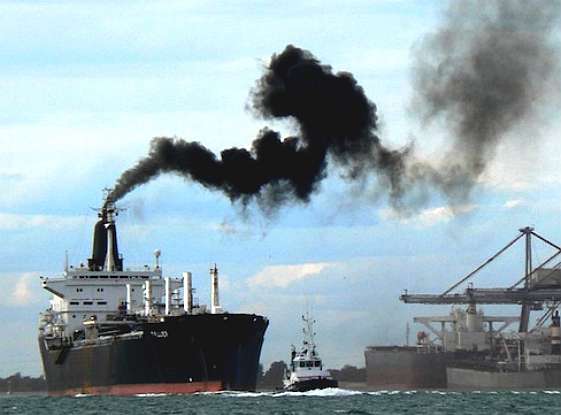
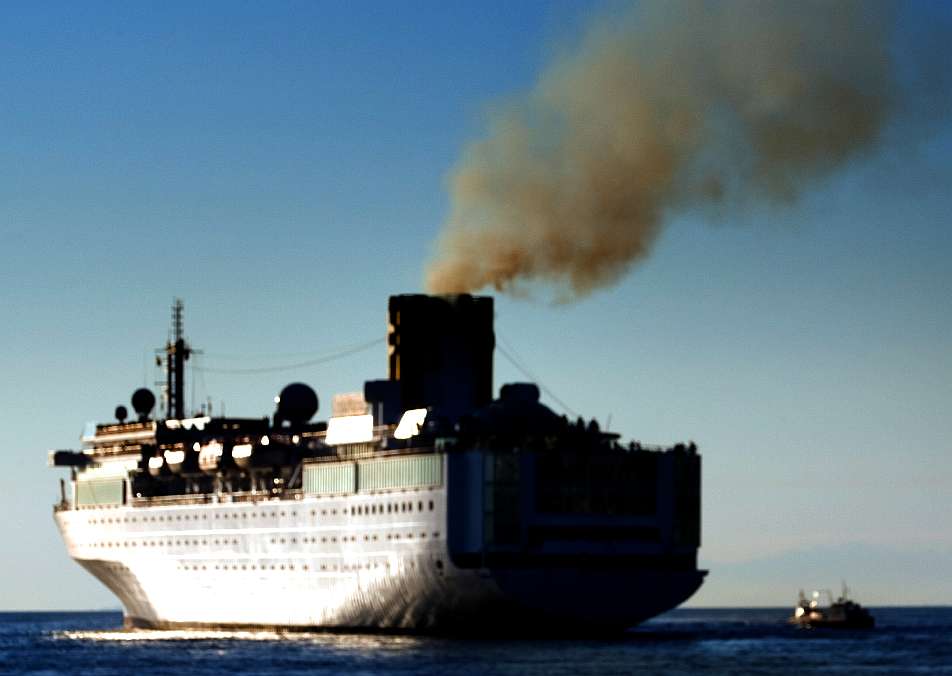
EXHAUST EMISSIONS
Exhaust emissions from ships are considered to be a significant source of air pollution, with 18 to 30 percent of all nitrogen oxide and 9 percent of sulphur oxide pollution. "By 2010, up to 40 percent of air pollution over land could come from ships." Sulfur in the air creates acid rain which damages crops and buildings. When inhaled the sulfur is known to cause respiratory problems and even increase the risk of a heart attack. According to Irene Blooming, a spokeswoman for the European environmental coalition Seas at Risk, the fuel used in oil tankers and container ships is high in sulfur and cheaper to buy compared to the fuel used for domestic land use. "A ship lets out around 50 times more sulfur than a lorry per metric tonne of cargo carried." Cities in the U.S. like Long Beach, Los Angeles, Houston, Galveston, and Pittsburgh see some of the heaviest shipping traffic in the nation and have left local officials desperately trying to clean up the air. Increasing trade between the U.S. and China is helping to increase the number of vessels navigating the Pacific and exacerbating many of the environmental problems. To maintain the level of growth China is experiencing, large amounts of grain are being shipped to China by the boat load. The number of voyages are expected to continue increasing.
3.5 to 4 percent of all climate change emissions are caused by shipping. Air pollution from cruise ships is generated by diesel engines that burn high sulfur content fuel oil, also known as bunker oil, producing sulfur dioxide, nitrogen oxide and particulate, in addition to carbon monoxide, carbon dioxide, and hydrocarbons. Diesel exhaust has been classified by EPA as a likely human carcinogen. EPA recognizes that these emissions from marine diesel engines contribute to ozone and carbon monoxide nonattainment (i.e., failure to meet air quality standards), as well as adverse health effects associated with ambient concentrations of particulate matter and visibility, haze, acid deposition, and eutrophication and nitrification of water. EPA estimates that large marine diesel engines accounted for about 1.6 percent of mobile source nitrogen oxide emissions and 2.8 percent of mobile source particulate emissions in the United States in 2000. Contributions of marine diesel engines can be higher on a port-specific basis. Ultra-low sulfur diesel (ULSD) is a standard for defining diesel fuel with substantially lowered sulfur contents. As of 2006, almost all of the petroleum-based diesel fuel available in Europe and North America is of a ULSD type.
As one way to reduce the impact of greenhouse gas emissions from shipping, vetting agency RightShip has developed an online “GHG Emissions Rating” as a systematic way for the industry to compare a ship’s CO2 emissions to peer vessels of a similar size and type. Using higher rated ships can deliver significantly lower CO2 emissions across the voyage length.
One source of environmental pressures on maritime vessels recently has come from states and localities, as they assess the contribution of commercial marine vessels to regional air quality problems when ships are docked in port. For instance, large marine diesel engines are believed to contribute 7 percent of mobile source nitrogen oxide emissions in Baton Rouge/New Orleans. Ships can also have a significant impact in areas without large commercial ports: they contribute about 37 percent of total area nitrogen oxide emissions in the Santa Barbara area, and that percentage is expected to increase to 61 percent by 2015. Again, there is little cruise-industry specific data on this issue. They comprise only a small fraction of the world shipping fleet, but cruise ship emissions may exert significant impacts on a local scale in specific coastal areas that are visited repeatedly. Shipboard incinerators also burn large volumes of garbage, plastics, and other waste, producing ash that must be disposed of. Incinerators may release toxic emissions as well.
In 2005 MARPOL Annex VI came into force to combat this problem. As such cruise ships now employ cctv monitoring on the smoke stacks as well as recorded measuring via opacity meter with some also using clean burning gas turbines for electrical loads and propulsion in sensitive areas.
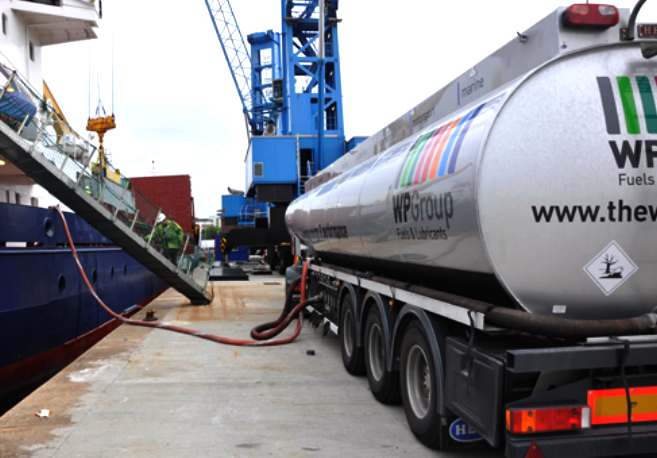
MARINE
FUEL MANAGEMENT
Marine fuel management (MFM) is a multi-level approach to measuring, monitoring, and reporting fuel usage on a boat or ship, with the goals of reducing fuel usage, increasing operational efficiency, and improving fleet management oversight. MFM has grown in importance due to the rising costs of marine fuel and increased governmental pressures to reduce the pollution generated by the world's fleet.
Effective MFM requires that you know:
* How much fuel is used
* How the fuel was used
* What things impact fuel usage
* And by how much
Manual methods of measuring fuel usage, i.e. fuel tank dipping or sounding, typically do not tell how much fuel was used:
* Traveling versus idling while in port or on station
* By a specific engine (port versus starboard, for example)
* Performing one job versus another
*By crew A versus crew B on similar voyages
Without a clear understanding of how fuel is being used, there is no operational baseline from which to compare any kind of fuel conservation tool or activity. Without a baseline, there is no way to determine if conservation strategies are actually working.
MFM allows a fleet owner to track actual fuel consumption and relate fuel consumption to the work performed by the vessel. It supports the analysis of the effectiveness of operating strategies and helps develop a clearer understanding of how well a vessel uses its fuel.
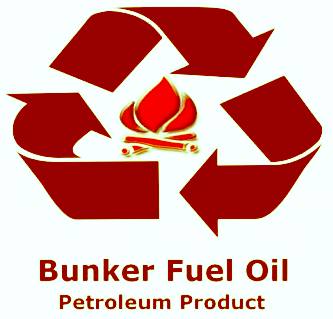
ALTERNATIVE
ENERGY
A
return to sails using autonomous
management of sail booms has been proposed and investigated in several
designs, the object being to eliminate manual trimming. Wing sails have
been shown to work, but have never taken off. Though, recent proposals by
Japanese ship builders include large sails on deck, a variation of the Walker
wing-sail system. Rotary wings, or turbines
is another area of harvesting energy from nature that is in its infancy,
Solar power has been used to circumnavigate
the globe, but at relatively slow speeds. Wave
power is another area receiving renewed attention.
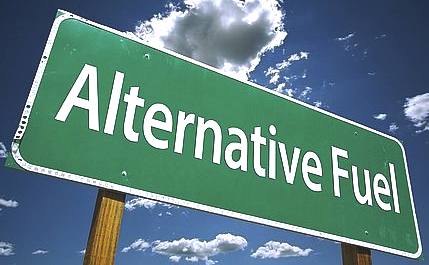
HORIZON
2020 - RESEARCH COLLABORATION OPPORTUNITY
The
EU is looking for proposals
that will eventually give zero, or near zero emission ocean transport.
Bluebird Marine Systems Ltd is looking for European partners to prove the
concept of a zero emission hybrid vessel that harvests a mix of solar and
wind energy to give cruising speeds that will be competitive against ships
using expensive bunker fuels. Please contact
us today if this is of interest to your organization.
LINKS
& REFERENCE
World
Energy News Pentagon uses wrong oil price fails hedge
http://www.worldenergynews.com/news/pentagon-uses-wrong-oil-price-fails-hedge-608106
http://www.epa.gov/
http://www.marinelink.com/news/investment-climate-could368625.aspx
http://articles.maritimepropulsion.com/article/EPA-Offers-$9-Million-for-Clean-Diesel-Projects21303.aspx
What-fuel-will-ocean-going-ships-be-burning-16-years-down-the-road
Liquid
minerals fuels
Platts
commodity oil
Platts
Shipping Bunker Fuel
PEJ
news
Assa-kz
Bunker
WP
marine bunker_fuel
Kittiwake
bunker fuel testing analysis
MARPOL
Marine_fuel_management
Merchant_Shipping_(Pollution)_Act_2006
Fuel_oils
Oil
investment risk as climate change rules enforced
https://www.bimco.org/
http://www.marinelink.com/news/ships-falls-fuel381234.aspx
http://www.liquidminerals.com/fuels.htm
http://www.platts.com/commodity/oil
http://www.platts.com/Shipping/BunkerFuel
http://pejnews.com
http://www.assa-kz.com/en/services/Bunker/
http://www.wp-marine.co.uk/bunker_fuel.html
http://www.kittiwake.com/bunker-fuel-testing-analysis
http://en.wikipedia.org/wiki/MARPOL
http://en.wikipedia.org/wiki/Marine_fuel_management
http://en.wikipedia.org/wiki/Merchant_Shipping_(Pollution)_Act_2006
http://en.wikipedia.org/wiki/Fuel_oil
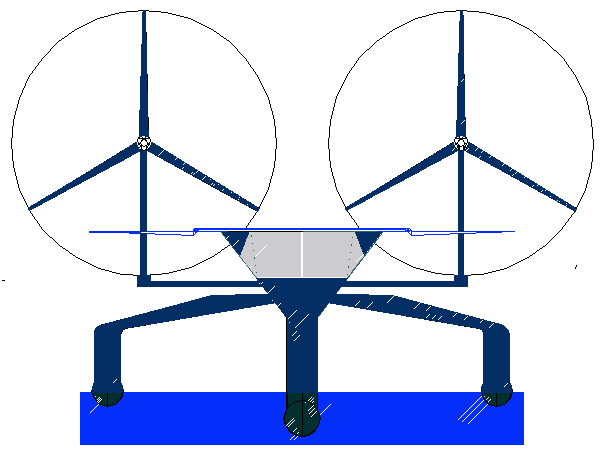
Forget
bunker fuel, electric ships are now possible that operate on nothing but energy
harvested directly from nature. The Combat ZCC above is a 50 ton
vessel with a low frontal area and hyper efficient SWASH hull, as with the
proposed merchant ZZC
platforms. This version is upgraded to 40kW wind turbines. The total
energy harvesting capacity of this design is around 176kW (235hp), giving an Energy
Harvested to Displacement ratio (EH/D) of 3.52kW/ton (4.72hp/ton). Larger
versions of this format could be the emission free cargo ships of
the future. The hull is 50m (163ft) hull on the waterline, length OAL is
56M (183ft). The sprint speed of this craft will be in the 20+ knot region
- dependent on active hull deployment and motor specifications.
The
cost of diesel fuel to operate this ship continuously for a year is
approximately: .29gals/hp x 117 x 24 x 365 = $297,226.80 (£183,393.99) In
ten years that would be $2.97M (£1.83M). Fuel for thought! Imagine
this craft unmanned
and 250m long with drones
for air
strikes. Rule Britannia!
|

















